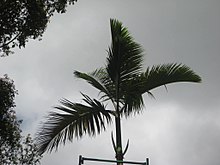Hyophorbe amaricaulis
| Hyophorbe amaricaulis | |
|---|---|

| |
| Scientific classification | |
| Kingdom: | Plantae |
| Clade: | Tracheophytes |
| Clade: | Angiosperms |
| Clade: | Monocots |
| Clade: | Commelinids |
| Order: | Arecales |
| Family: | Arecaceae |
| Genus: | Hyophorbe |
| Species: | H. amaricaulis
|
| Binomial name | |
| Hyophorbe amaricaulis | |
| Synonyms | |
| |
Hyophorbe amaricaulis(also known as the "loneliest palm")[2]is a species of palm tree of the orderArecales,familyArecaceae,subfamilyArecoideae,tribeChamaedoreeae.It is found exclusively on the island ofMauritius,and only asingle survivingspecimen[3]has been documented in theCurepipe Botanic GardensinCurepipe.Thus, it is classified as anendling.
Distribution
[edit]This species is one of nine species of palm which are indigenous toMauritius,and one of the seven palms which are alsoendemic.
In the 1700s, this palm species was described from specimens taken from the mountainPieter Both,where it seems to have been widespread at the time.[4]
Currently, only the single specimen exists inCurepipe Botanic Gardens,[5]and it is not known if this specimen was planted here, or was a survivor from the area's wild population that became included when the gardens were established.
Description
[edit]
The palm is about 12 metres (39 ft) high with a relatively thin gray trunk with a waxy crown shank.
It is related to thebottle palmandspindle palm.It is said to resemble the green variety ofH. indica– anotherHyophorbepalm species which also does not develop a swollen trunk.
It is reported to have white to cream-colored flowers on aninflorescencewith three-ordered branching. Its fruits are 3.8 cm (1.5 in) long and a dull red colour, but years and years of efforts have not resulted in fertile offspring.
A study in 2010 reported successful germination in vitro (by isolating and growing embryos extracted from seeds in tissue culture). The young green seedlings grew for about three months but later died.[6]
References
[edit]- ^Bachraz, V.; Strahm, W.; et al. (TPTNC) (2000)."Hyophorbe amaricaulis".The IUCN Red List of Threatened Species.2000:e.T38578A10125958.doi:10.2305/IUCN.UK.2000.RLTS.T38578A10125958.en.Retrieved8 October2022.
- ^"Loneliest palm (Hyophorbe amaricaulis)".ARKive. Archived fromthe originalon 2013-02-04.Retrieved31 January2013.
- ^Mabberley, D.J. (1997).The Plant-Book, 2nd Ed.Cambridge University Press,UK.ISBN0-521-41421-0.
- ^Maunder, Mike; Page, Wayne; Mauremootoo, John; Payendee, Richard; Mungroo, Yousoof; Maljkovic, Aleks; Vericel, Christian; Lyte, Ben (January 2002)."The decline and conservation management of the threatened endemic palms of the Mascarene Islands".Oryx.36(1): 56–65.doi:10.1017/S0030605302000091.ISSN1365-3008.
- ^Ian Parker (January 22, 2007)."Digging for Dodos".The New Yorker.pp. 64–73.
- ^Sarasan, Viswambharan (2010-12-01)."Importance of in vitro technology to future conservation programmes worldwide".Kew Bulletin.65(4): 549–554.Bibcode:2010KewBu..65..549S.doi:10.1007/s12225-011-9250-7.ISSN1874-933X.
- This article is based in part on thearticle in the German Wikipedia.
External links
[edit]![]() Media related toHyophorbe amaricaulisat Wikimedia Commons
Media related toHyophorbe amaricaulisat Wikimedia Commons

